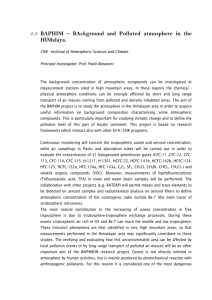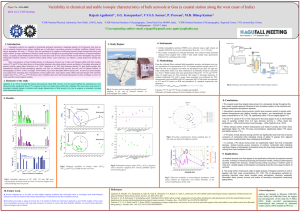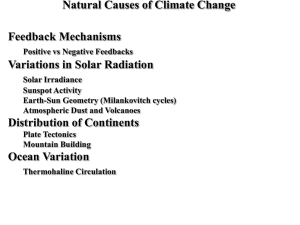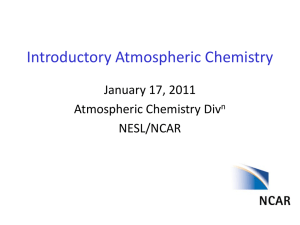Introduction to atmospheric aerosols
advertisement
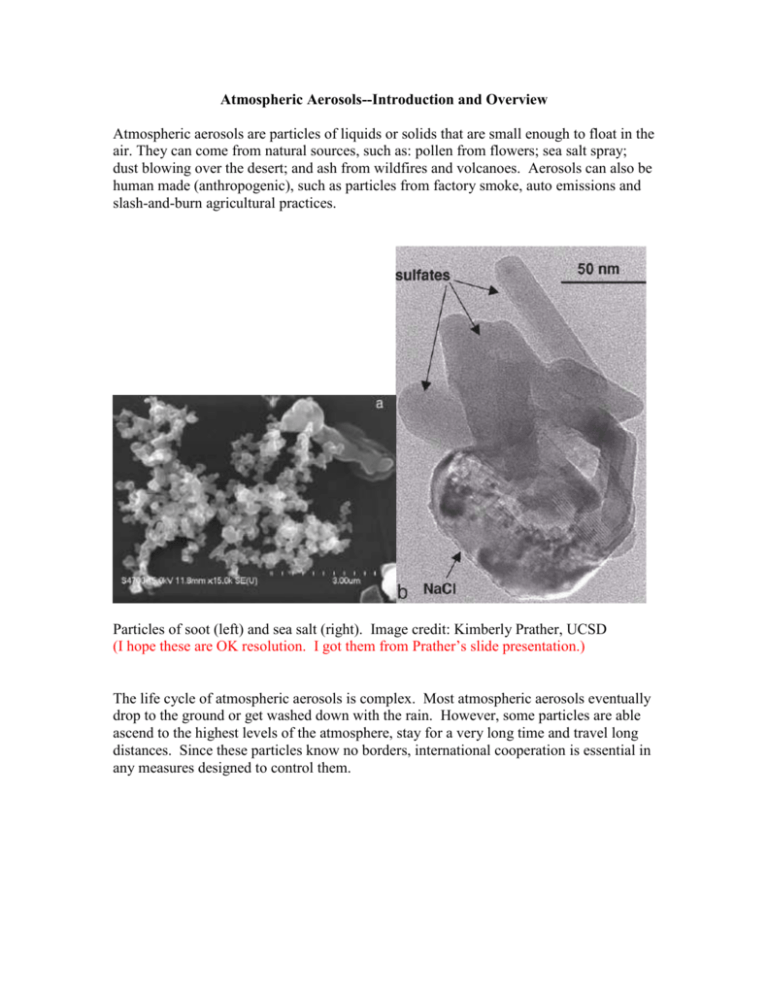
Atmospheric Aerosols--Introduction and Overview Atmospheric aerosols are particles of liquids or solids that are small enough to float in the air. They can come from natural sources, such as: pollen from flowers; sea salt spray; dust blowing over the desert; and ash from wildfires and volcanoes. Aerosols can also be human made (anthropogenic), such as particles from factory smoke, auto emissions and slash-and-burn agricultural practices. Particles of soot (left) and sea salt (right). Image credit: Kimberly Prather, UCSD (I hope these are OK resolution. I got them from Prather’s slide presentation.) The life cycle of atmospheric aerosols is complex. Most atmospheric aerosols eventually drop to the ground or get washed down with the rain. However, some particles are able ascend to the highest levels of the atmosphere, stay for a very long time and travel long distances. Since these particles know no borders, international cooperation is essential in any measures designed to control them. Global seasonal atmospheric aerosol distributions (Original image at: http://www-misr.jpl.nasa.gov/gallery/galhistory/2003_jun_04.html) Image Credit: NASA/GSFC/LaRC/JPL, MISR Team Atmospheric aerosols are not inert and unchanging. For example, particles may combine with each other. Also, some aerosols are created in the atmosphere from gases, including nitric oxide, nitrogen dioxide, sulfur dioxide and hydrocarbons. Aerosols that arise from gas to particle conversions are known as secondary aerosols to distinguish them from primary aerosols, which are emitted directly into the atmosphere. Effects of Atmospheric Aerosols 1. Health According to the American Academy of Allergy, Asthma and Immunology, approximately 20 million Americans have asthma, and the prevalence of asthma has increased dramatically in recent decades. The cause of this increase is not well understood, but aerosols, both natural and anthropogenic, create serious challenges for people with asthma or other lung problems, and children growing up in heavily polluted cities have lowered lung function. Asthma costs Americans billions of dollars every year. Very fine particulates (2.5 micrometers or less in diameter) can penetrate deep into the lungs. The finest particles can also leave the lungs to enter the bloodstream and affect other parts of the body, especially as carcinogens. 2. Ozone Layer The hole in the ozone layer above Antarctica (Original image at: http://rsd.gsfc.nasa.gov/rsd/images/NGSAW/) Image credit Fritz Hasler and Hal Pierce, Laboratory for Atmospheres, NASA Goddard Space Flight Center. High up in the atmosphere is a layer called the stratosphere. Part of the stratosphere is the ozone layer, which absorbs ultraviolet B wavelengths. UVB is known to cause skin cancer; therefore a healthy ozone layer is very important to human health. Many synthetic products once contained chlorine compounds called chlorofluorocarbons (CFCs) that can end up in the stratosphere or even higher. Some other ozone depleting substances, including methyl bromide and methyl chloroform, are still used as insecticides and industrial solvents. Chlorine or bromine from ozone depleting substances reacts with ozone in the stratosphere, diminishing the ozone layer. Aerosol particles that are able to drift all the way up to the stratosphere are thought to provide a surface on which chlorine can react with ozone more rapidly. In other words, atmospheric aerosols can make chlorine more effective at destroying ozone. 3. Global Climate Change Aerosols are a major uncertainty in studies of global climate change. They can have both direct and indirect effects on climate, and depending on what effects predominate, may either contribute to global cooling or global warming. The emission of sulfur dioxide from the burning of coal and oil are of particular concern, because not only does some of this end up as acid rain (another serious environmental problem), but a large fraction becomes sulfate aerosols. (Please insert image on Powerpoint slide: Aerosol_climatechange) The direct effects of aerosols are the scattering (which causes cooling) and absorption (which causes warming) of sunlight. High concentrations of aerosols in certain localities may cause local warming, which can alter air currents. Atmospheric aerosols can also affect climate indirectly by acting as “cloud condensation nuclei,” which make the liquid droplets in clouds smaller. Clouds with smaller droplets have longer lifetimes and reflect more sunlight. Smoke stacks from cruise ships eject aerosols, and satellites can chart ship’s progress across the ocean because they leave an artificial cloud trail behind them. ……………………………………………………………………….. (To include under Multimedia—Atmospheric Chemistry) These can be listed as the last item on the Multimedia page, just beneath the link to the Monitoring Atmospheric Aerosols video Additional Resources Background information on atmospheric aerosols from NASA Facts On-line http://oea.larc.nasa.gov/PAIS/Aerosols.html Earth’s atmosphere basics from NASA http://liftoff.msfc.nasa.gov/academy/space/atmosphere.html Health effects of atmospheric aerosols Statistics and resources on asthma are available from the American Academy of Allergy, Asthma and Immunology http://www.aaaai.org/media/resources/media_kit/asthma_statistics.stm Information on the heath effects of air pollution from the American Lung Association http://www.californialung.org/spotlight/cleanair03_research.html Discussion of air quality index and particulate matter from the University of Michigan http://www.globalchange.umich.edu/globalchange1/current/lectures/samson/aerosols/ Effects of atmospheric aerosols on the ozone layer A description of ozone balance, ozone depletion and the difference between “good” and “bad” ozone is available from NASA’s SOLAR http://asd-www.larc.nasa.gov/SOLAR/learning-ozone.html Detailed information about ozone, ozone depletion, common myths about ozone, a link to the Montreal Protocol, etc. available from the Environmental Protection Agency http://0-www.epa.gov.library.unl.edu:80/ozone/science/aerosol.html Climate effects of atmospheric aerosols “Human-produced Aerosols in Many Arctic Clouds Contribute to Climate Warming” from the Scripps Institution of Oceanography Center for Atmospheric Sciences http://scrippsnews.ucsd.edu/article_detail.cfm?article_num=712 Clouds, aerosols and climate change information from NASA’s Earth Observatory http://earthobservatory.nasa.gov/Library/CALIPSO/ Atmospheric aerosols visualizations and data sets Use of satellites and animations to distinguish human pollution from other atmospheric particles by NASA’s Earth Observatory http://earthobservatory.nasa.gov/Newsroom/Aerosols/ Air quality real time images from the USDA Forest Service http://www.fsvisimages.com/all.html Global aerosol and ozone mapping from NASA http://toms.gsfc.nasa.gov/ Atmospheric animations from NASA’s Ice, Cloud and land Elevation Satellite (ICES) http://icesat.gsfc.nasa.gov/list.htm More about the techniques used to study atmospheric aerosols from The National Oceanic and Atmospheric Administration (NOAA) http://www.oar.noaa.gov/atmosphere/atmos_al.html Air Quality Legislation Federal air quality legislation from the U.S. Department of Transportation Federal Highway Administration http://www.fhwa.dot.gov/resourcecenter/teams/airquality/publications.cfm Link to the South Coast Air Quality Management District http://www.aqmd.gov/smog/inhealth.html



